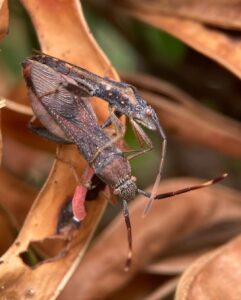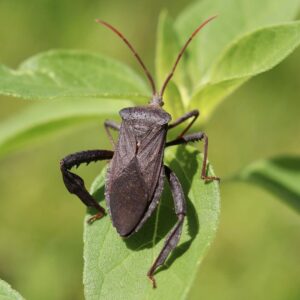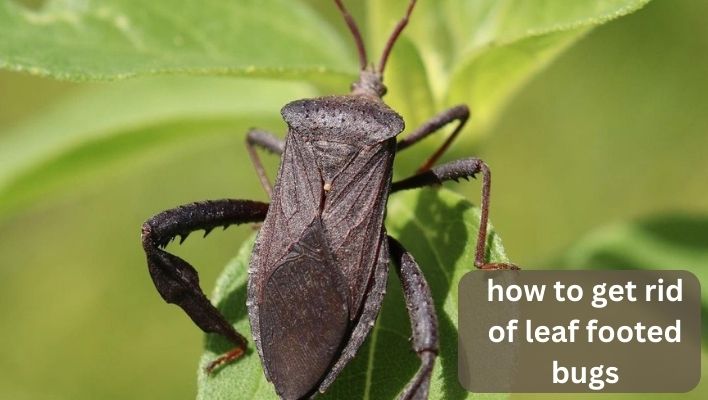Leaf-footed bugs are a type of true bug that belongs to the Coreidae family. These bugs are also known as leaf-legged bugs due to the leaf-like structure on their hind legs. They can damage plants and yield, which makes it necessary to know how to get rid of these leaf-footed bugs.
Leaf-footed bugs can be found in gardens, orchards, and agricultural fields and are known for their piercing-sucking mouthparts that they use to feed on the sap of plants.
Leaf-footed bugs can cause significant damage to plants by feeding on them, leading to stunted growth, wilting, and even death.
They also introduce harmful bacteria and viruses into your plants, further weakening them. Therefore, getting rid of leaf-footed bugs is important to protect your plants and crops from damage.
In this article, we will provide you with a comprehensive guide on how to get rid of leaf-footed bugs. We will cover everything from identifying leaf-footed bugs to natural and chemical ways of controlling them. By the end of this article, you will better understand how to prevent and control leaf-footed bug infestations in your garden or farm.
Identify Leaf-Footed Bugs
Leaf-footed bugs have a distinctive appearance that makes them easy to identify. They are about 1 inch long and have a brownish body with a flattened, leaf-like structure on their hind legs. They also have long antennae and wings that overlap at the tips.
Leaf-footed bugs are primarily herbivores and feed on the sap of plants using their piercing-sucking mouthparts. They prefer to feed on fruits and vegetables like tomatoes, peppers, and citrus fruits.
Their feeding can cause the fruits to become discolored, deformed, and drop prematurely. In addition to feeding on plants, leaf-footed bugs may seek shelter in buildings during the colder months.

One of the signs of a leaf-footed bug infestation is the appearance of discolored or deformed fruits and vegetables. You may also notice the bugs themselves on or around the affected plants. Acting quickly is important to prevent further crop damage if you suspect an infestation.
Why do you need to get rid of them?
Leaf-footed bugs can cause significant damage to crops and plants, reducing the yield and quality of fruits and vegetables. They use their piercing-sucking mouthparts to feed on the sap of plants, which can cause damage and stunted growth.
If left unchecked, leaf-footed bug infestations can result in significant crop loss. Also, leaf-footed bugs can transmit plant diseases and attract pests like ants and wasps. Therefore, getting rid of leaf-footed bugs is important to protect your plants and ensure a healthy crop yield.
Natural Ways to Get Rid of Leaf-Footed Bugs
There are several options if you’re looking for a natural way to get rid of leaf-footed bugs. These safe and environmentally friendly methods make them a great choice for those who want to avoid harsh chemicals.
Handpicking
One of the easiest ways to get rid of leaf-footed bugs is to handpick them off your plants. Wear gloves and pick the bugs off individually, dropping them into a bucket of soapy water. This method is most effective in the early morning or late afternoon when the bugs are less active.
Traps
You can also use traps to catch leaf-footed bugs. Place yellow sticky traps near your plants to attract and trap the bugs. You can also make your own trap by hanging a damp cloth near the plants. The bugs will be attracted to moisture and can be easily removed from the cloth.
Beneficial Insects
Introducing beneficial insects to your garden, such as ladybugs and lacewings, can help control leaf-footed bugs. These insects feed on the eggs and larvae of leaf-footed bugs, preventing them from becoming problematic.
Essential Oils
Essential oils like neem and peppermint can also effectively repel leaf-footed bugs. Mix a few drops of the oil with water and spray it on your plants. The scent will repel the bugs and prevent them from feeding on your plants.
Diatomaceous Earth
Diatomaceous earth is a natural and non-toxic powder made from the fossilized remains of tiny aquatic organisms called diatoms. It works by penetrating the exoskeleton of insects, causing them to dehydrate and die.
To use diatomaceous earth for leaf-footed bug control, sprinkle a thin layer of the powder around the base of affected plants, focusing on the areas where the bugs are most active. Be sure to wear a mask and gloves when handling diatomaceous earth, as it can irritate the lungs and skin.

Neem Oil
Neem oil is a natural oil extracted from the neem tree’s seeds. It has insecticidal properties that can help control leaf-footed bugs. To use neem oil for leaf-footed bug control, mix 1-2 tablespoons of neem oil with a gallon of water and spray the affected plants, thoroughly covering both the tops and undersides of leaves. Repeat every 7-14 days as necessary.
Row Covers
Row covers are lightweight, breathable fabrics that can be used to cover plants and protect them from insects, including leaf-footed bugs. To use row covers for leaf-footed bug control, place the cover over the affected plants and secure the edges to prevent insects from getting in. Be sure to remove the covers once your plants begin to flower to allow for pollination.
Remember, natural methods may not eliminate leaf-footed bugs, but they can help reduce their numbers and prevent further plant damage, so it is always advisable to go for chemical control.
Chemical Control of Leaf-Footed Bugs
If you have a severe infestation of leaf-footed bugs, you may need to use chemical control methods to eliminate them. Here are some options:
Insecticides can be an effective way to control leaf-footed bugs. Look for insecticides that contain pyrethroids, neonicotinoids, or carbamates, which are effective against these pests.
Be sure to follow the instructions on the label carefully and wear protective clothing when applying insecticides.
Syngenta 73654 Demand CS Insecticide
Syngenta 73654 Demand CS Insecticide is a professional-strength insecticide that can control many pests, including leaf-footed bugs. It contains the active ingredient lambda-cyhalothrin, a synthetic pyrethroid that disrupts the nervous system of insects, causing paralysis and death.
To use Syngenta 73654 Demand CS Insecticide for leaf-footed bug control, mix the recommended amount of insecticide with water in a sprayer and apply it to affected plants, focusing on the areas where the bugs are most active.
BioAdvanced 3-in-1 Insect Disease and Mite Control
BioAdvanced 3-in-1 Insect Disease and Mite Control is a ready-to-spray insecticide that can control various pests, including leaf-footed bugs. It contains the active ingredient lambda-cyhalothrin, a synthetic pyrethroid that disrupts the nervous system of insects, causing paralysis and death.
To use BioAdvanced 3-in-1 Insect Disease and Mite Control for leaf-footed bug control, attach the sprayer to a garden hose and spray the affected plants, thoroughly covering both the tops and undersides of leaves. Be sure to follow the label instructions carefully, as the application rates may vary depending on the severity of the infestation and the type of plant being treated.
Ortho BugClear Insect Killer for Lawns & Landscapes Ready to Spray
Ortho BugClear Insect Killer for Lawns & Landscapes Ready to Spray is a ready-to-spray insecticide that can control various pests, including leaf-footed bugs. It contains the active ingredient bifenthrin, a synthetic pyrethroid that disrupts the nervous system of insects, causing paralysis and death.
To use Ortho BugClear Insect Killer for Lawns & Landscapes Ready to Spray for leaf-footed bug control, attach the sprayer to a garden hose and spray the affected plants, making sure to cover both the tops and undersides of leaves thoroughly.
Note: It’s important to note that chemical control methods should be used as a last resort and should only be applied when necessary. Always follow the label instructions carefully and wear protective clothing when applying insecticides.
Prevention of Leaf-Footed Bugs
Preventing leaf-footed bug infestations is the best way to avoid dealing with them later. Here are some prevention tips:
. Prevention of Leaf-Footed Bugs Preventing leaf-footed bugs from infesting your plants is the best way to avoid the need for chemical control methods. Here are some prevention methods to consider:
- Monitor Your Plants: Regularly inspect your plants for signs of leaf-footed bug activity. Look for the distinctive brownish bodies with the flattened, leaf-like structure on their hind legs. If you spot any, take action right away to prevent the infestation from spreading.
- Maintain Cleanliness: Keep your garden clean and free of debris, as leaf-footed bugs tend to hide in piles of dead leaves and plant debris. This can also attract other pests that can spread disease.
- Install Physical Barriers: Installing physical barriers such as row covers, or mesh screens can help prevent leaf-footed bugs from accessing your plants. Be sure to secure the edges of the barriers to prevent the bugs from getting in.
- Rotate Your Crops Leaf-footed bugs tend to be attracted to specific types of plants, so rotating your crops can help prevent infestations. This can also help improve the overall health of your soil and plants.
- Use Companion Planting Some plants can help repel leaf-footed bugs. Consider planting companion plants such as marigolds, basil, or garlic, which are known to repel these pests.
- Use Row Covers Using row covers can help prevent leaf-footed bugs from infesting your plants. Row covers are a physical barrier preventing pests from reaching your plants. Be sure to use covers designed to allow air and water to penetrate, and remove them when your plants begin to flower to allow for pollination.
Conclusion
Leaf-footed bugs can be a serious pest for gardeners and farmers alike, causing damage to crops and plants. However, with proper identification, control methods, and prevention techniques, you can effectively manage these pests and protect your plants.
While chemical control methods can be effective, using them as a last resort and following the label instructions carefully is important. By practicing prevention methods, such as planting resistant varieties, crop rotation, and regular monitoring, you can reduce the likelihood of infestations and avoid the need for chemical controls.
With these tips, you can successfully get rid of leaf-footed bugs and enjoy a healthy, productive garden or farm.



